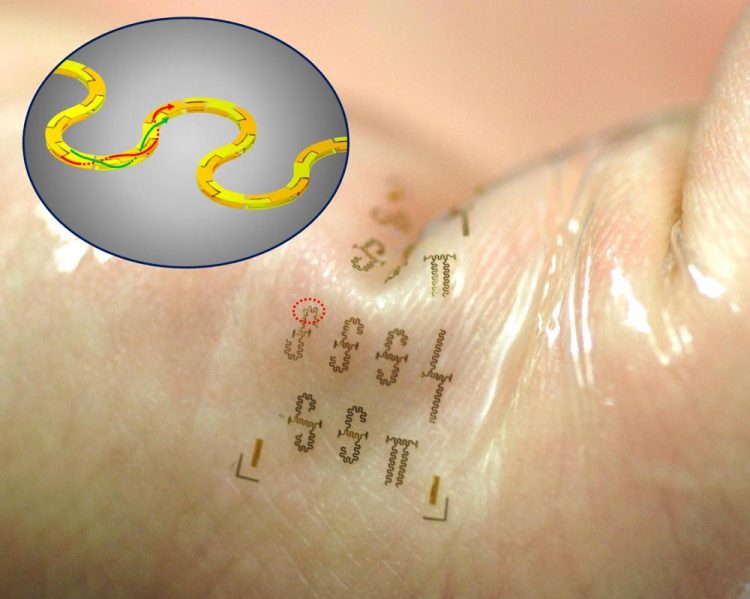Fast, stretchy circuits could yield new wave of wearable electronics

Fabricated in interlocking segments like a 3-D puzzle, the new integrated circuits could be used in wearable electronics that adhere to the skin like temporary tattoos. Because the circuits increase wireless speed, these systems could allow health care staff to monitor patients remotely, without the use of cables and cords. Image courtesy of Yei Hwan Jung and Juhwan Lee/University of Wisconsin-Madison
Now, a team of University of Wisconsin-Madison engineers has created the world's fastest stretchable, wearable integrated circuits, an advance that could drive the Internet of Things and a much more connected, high-speed wireless world.
Led by Zhenqiang “Jack” Ma, the Lynn H. Matthias Professor in Engineering and Vilas Distinguished Achievement Professor in electrical and computer engineering at UW-Madison, the researchers published details of these powerful, highly efficient integrated circuits today, May 27, 2016, in the journal Advanced Functional Materials.
The advance is a platform for manufacturers seeking to expand the capabilities and applications of wearable electronics — including those with biomedical applications — particularly as they strive to develop devices that take advantage of a new generation of wireless broadband technologies referred to as 5G.
With wavelength sizes between a millimeter and a meter, microwave radio frequencies are electromagnetic waves that use frequencies in the .3 gigahertz to 300 gigahertz range. That falls directly in the 5G range.
In mobile communications, the wide microwave radio frequencies of 5G networks will accommodate a growing number of cellphone users and notable increases in data speeds and coverage areas.
In an intensive care unit, epidermal electronic systems (electronics that adhere to the skin like temporary tattoos) could allow health care staff to monitor patients remotely and wirelessly, increasing patient comfort by decreasing the customary tangle of cables and wires.
What makes the new, stretchable integrated circuits so powerful is their unique structure, inspired by twisted-pair telephone cables. They contain, essentially, two ultra-tiny intertwining power transmission lines in repeating S-curves.
This serpentine shape — formed in two layers with segmented metal blocks, like a 3-D puzzle — gives the transmission lines the ability to stretch without affecting their performance. It also helps shield the lines from outside interference and, at the same time, confine the electromagnetic waves flowing through them, almost completely eliminating current loss. Currently, the researchers' stretchable integrated circuits can operate at radio frequency levels up to 40 gigahertz.
And, unlike other stretchable transmission lines, whose widths can approach 640 micrometers (or .64 millimeters), the researchers' new stretchable integrated circuits are just 25 micrometers (or .025 millimeters) thick. That's tiny enough to be highly effective in epidermal electronic systems, among many other applications.
Ma's group has been developing what are known as transistor active devices for the past decade. This latest advance marries the researchers' expertise in both high-frequency and flexible electronics.
“We've found a way to integrate high-frequency active transistors into a useful circuit that can be wireless,” says Ma, whose work was supported by the Air Force Office of Scientific Research. “This is a platform. This opens the door to lots of new capabilities.”
###
Other authors on the paper include Yei Hwan Jung, Juhwan Lee, Namki Cho, Sang June Cho, Huilong Zhang, Subin Lee, Tong June Kim and Shaoqin Gong of UW-Madison and Yijie Qiu of the University of Electronic Science and Technology of China.
–Renee Meiller, meiller@engr.wisc.edu, 608-262-2481
DOWNLOAD PHOTO: https:/
Media Contact
All latest news from the category: Power and Electrical Engineering
This topic covers issues related to energy generation, conversion, transportation and consumption and how the industry is addressing the challenge of energy efficiency in general.
innovations-report provides in-depth and informative reports and articles on subjects ranging from wind energy, fuel cell technology, solar energy, geothermal energy, petroleum, gas, nuclear engineering, alternative energy and energy efficiency to fusion, hydrogen and superconductor technologies.
Newest articles

Superradiant atoms could push the boundaries of how precisely time can be measured
Superradiant atoms can help us measure time more precisely than ever. In a new study, researchers from the University of Copenhagen present a new method for measuring the time interval,…

Ion thermoelectric conversion devices for near room temperature
The electrode sheet of the thermoelectric device consists of ionic hydrogel, which is sandwiched between the electrodes to form, and the Prussian blue on the electrode undergoes a redox reaction…

Zap Energy achieves 37-million-degree temperatures in a compact device
New publication reports record electron temperatures for a small-scale, sheared-flow-stabilized Z-pinch fusion device. In the nine decades since humans first produced fusion reactions, only a few fusion technologies have demonstrated…





















